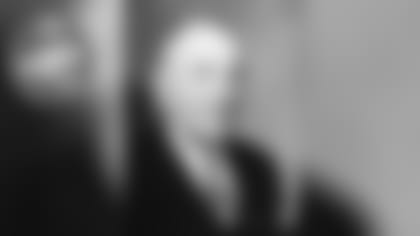One would hope that Chris Willis' new book on the NFL's greatest players of the Iron Man era will convince members of the Pro Football Hall of Fame's senior committee to take a serious look at Verne Lewellen when picking next year's finalists.
Willis, NFL Films archivist and historian, recently published "The NFL's 60-Minute Men: All-Time Greats of the Two-Way Player Era, 1920-1945." In an exhaustively researched book, Willis listed his choices for the top 45 players of the NFL's first 26 seasons – or one-quarter of the league's history – and ranked Lewellen seventh.
Not only was Lewellen the highest-ranked player not in the Pro Football Hall of Fame, he was placed one spot behind Bronko Nagurski and one ahead of Sid Luckman, arguably the two greatest Chicago Bears when they won six of the franchise's nine NFL titles.
The Packers also won six during Willis' "Two-Way Player Era," and only Don Hutson from that period was ranked ahead of Lewellen. Willis ranked Hutson second. Other Packers ranked in the top 45 included Cal Hubbard, ninth; Clarke Hinkle, 13th; Mike Michalske, 16th; Johnny Blood, 21st; Arnie Herber, 26th; Lavvie Dilweg, 36th; Cecil Isbell, 38th; Red Dunn, 40th and Charley Brock, 43rd. Dilweg, Isbell, Dunn and Brock aren't in the Pro Football Hall of Fame, either.
In all, Willis ranked 13 players who haven't been inducted into Canton, but 10 were among his last 11 choices. Ward Cuff, who was ranked 32nd, played his 11th and final season with the Packers in 1947.
Granted, Willis' ranking was a subjective process. But I also would contend that it involved far more extensive research than what went into the Professional Football Researchers Association's stance on the subject, posted at its website, and what goes into the selection of the Hall of Fame's senior nominees.
It's hard to imagine any true historian willing to invest the time to research Iron Man era players not coming to the same conclusion about Lewellen, who played for the Packers from 1924-32: That he should be in the conversation about the greatest Packers player ever, or at least pre-Brett Favre and Aaron Rodgers.
Read Packers game stories, play-by-plays and other clippings in the Green Bay and Milwaukee newspapers, as well as those in other NFL cities, and I'm confident you'll find overwhelming proof of his game-after-game dominance.
How is it then that Lewellen isn't in the Pro Football Hall of Fame?
One obvious answer is that he played in the NFL's pre-stats era – the league didn't start compiling official statistics until 1932 – and so there are no official numbers to confirm Lewellen's all-around talents, other than his record touchdown total. Also, there were no league MVP selections, although Willis picked Lewellen as the NFL's retroactive MVP for the 1929 and '30 seasons in the preface of his book.
As for some of the other reasons, let's start in 1963, when the Hall of Fame opened and inducted its first class, 31 years after Lewellen retired.
First, based on several letters available at the Ralph Wilson Research Center in Canton, it appears that Dick McCann, the hall's first director, had limited knowledge of early Packers history and was attempting to arrange a meeting with Packers cofounder George Calhoun in early 1963 to learn more.
"I look forward to getting together with you because I don't know of anyone who could help me more in this staggering job," McCann wrote Calhoun in February of that year. A month later, McCann again wrote to Calhoun telling him, "I don't think there is anybody else who has a greater store of knowledge on pro football."
However, Calhoun died of cancer in December 1963, and a meeting never took place.
Calhoun was one of 16 contributor candidates listed on the Hall of Fame's original ballot. No doubt, that was based on his "precious and massive files" that, according to the preface, made it possible to publish the NFL's first sanctioned official encyclopedia; his weekly pro football notes column that he started in the 1920s and evolved into the "Football News Bulletin" that appeared in newspapers across the country in the 1930s and '40s; and for paving the way for the league's official all-pro teams.
In 1954, when NFL Commissioner Bert Bell learned that Calhoun would no longer be writing his bulletin, he wrote in a letter to him: "I want you to know for myself and the members of the National Football League we deeply appreciate everything you have done for us."
Had Calhoun met with McCann, presumably he would have shared what he had written about Lewellen being the best of the Packers' halfbacks and "the man who sparked Green Bay to three straight titles," and "one of the greatest" in the history of the NFL.
The hall's selection committee that first year included an august group of 12 sportswriters, representing the NFL teams they covered. Arthur Daley of The New York Times, for one, had covered games where Lewellen played and written about him. In addition, Paul Menton, then of the Baltimore Evening Sun, had been the head linesman in at least two Packers-Frankford Yellowjackets games in 1927 and '29, when Lewellen played. Menton had served as an NFL official from 1923-28.
Otherwise, in those days before television, there would have been less than a handful of committee members who had started working for newspapers early enough, where they conceivably could have covered a game involving Lewellen. Art Daley of the Press-Gazette represented Green Bay but didn't start covering the Packers until 1941.
The other two committee members were former players: Jim Conzelman, representing St. Louis, and Davey O'Brien, representing Dallas. Conzelman was a contemporary of Lewellen's, and they faced each other several times. O'Brien was 15 years old in Lewellen's final season and didn't play in the NFL until 1939.
Two owners, George Halas of Chicago and Art Rooney of Pittsburgh, were named to the Hall of Fame's original board of trustees and also had considerable say in the selection process based on newspaper accounts from that period. Halas, like Conzelman, faced Lewellen many times. Rooney entered the league in 1933, a year after Lewellen retired.
In 1981, Jack MacDonald, who had represented San Francisco as a writer for that city's Call-Bulletin, wrote an article on that first meeting for an NFL game program, suggesting there wasn't a lot of disagreement over the 17 selections and that Halas and Conzelman had supplied "vital information" on the linemen, in particular.
If there was any controversy over them, it involved Blood, who played halfback for the Packers alongside Lewellen from 1929-32. "John was a fine football player," Conzelman told sports columnist Robert Burnes of the St. Louis Globe-Democrat, "but this group consisted of superstars, guys who could do everything. I can't quite reconcile myself to the idea that John fits into this category."
Blood himself told the Press-Gazette's Art Daley following the announcement: "Verne Lewellen should have been in there in front of me and (Cal) Hubbard."
But word was that Rooney persisted on his good friend being part of the class. Blood had played and coached for Rooney in Pittsburgh, mostly after his years in Green Bay.
A year later, the second hall class included Conzelman and Rooney. The Press-Gazette's Daley reported later that Conzelman, who played the same position as Lewellen and still a member of the selection committee, wouldn't leave the room during deliberations over his candidacy. Hence, the selectors decided to elect Conzelman and Rooney as a tandem by voice vote when a unanimous vote was required for induction.
Conzelman had played 10 years with five different teams, from 1920-29, and was named first-team all-pro once on one team in 1923. His coaching record over 15 seasons, eight as a player-coach, was 87-63-17, a .580 winning percentage, with two NFL titles. Rooney's Steelers, at that point, had been in the league 31 seasons, had lost a divisional playoff in their only postseason appearance and had finished with a winning record only seven times.
Today, there are 22 players in the Pro Football Hall of Fame who began their careers in the 1920s, including player-coach inductees: Guy Chamberlin, Conzelman, Halas, Walt Kiesling, Steve Owen and Fritz Pollard. Kiesling, by the way, another good friend of Rooney's, compiled a 30-55-5 record in nine years as a head coach and is listed in that category in Canton.
Eighteen of the 22 were inducted in the first four classes. The other four were inducted as senior candidates.
To be sure, the confusion over Lambeau's induction in the charter class probably hasn't helped Lewellen, either. Today, at the Pro Football Hall of Fame website, Lambeau is listed as a Contributor, Halfback and Head Coach.
However, the 2023 National Football League Record & Fact Book listed Lambeau strictly as a "Coach" in its Hall of Fame section and has done so since 1977. Previously, it listed him as a founder, player, coach.
The hall's original ballot listed Lambeau as a "Non-Players" candidate. The Press-Gazette's Art Daley, a participant in the first meeting, wrote in the 1963 Green Bay Packers Yearbook in a story about the hall's charter class that Lambeau had been selected as a founder and head coach. Daley also noted that Halas was chosen as an Owner-Coach. Today, the Hall of Fame website lists Halas as a "Head Coach, Contributor, End, Contributor." The NFL Record & Fact Book lists him as "End. Coach."
Seems like with something of that importance the NFL and the Hall of Fame would be on the same page.
Whatever, there was and remains a lingering perception, probably even among hall voters, that Lambeau, not Lewellen, was the Packers' first star back. That was true, but only briefly.
In 1923, the Press-Gazette published the first all-NFL team based on leaguewide polling as conducted by Calhoun, then the paper's sports editor. Beyond that, Calhoun continued his polling through 1935, except for 1932, reaching out at first to sportswriters in other league cities, then game officials, team managers and owners, and eventually league coaches. The Press-Gazette selections were also published by newspapers in other league cities and evolved into the NFL's official all-pro team in 1931.
In the 13 years that Calhoun conducted the voting, Lewellen was named to the first team four times and to the second team once. Lambeau made the second team twice before suffering a knee injury in 1925 that curtailed his career.
In 1969, a then 16-member Hall of Fame selection committee with eight different voters from six years earlier and the Times' Arthur Daley almost certainly the only one to have seen Lewellen play, selected a 1920s NFL All-Decade team. Although Lewellen was the only halfback in the entire league to have made first team more than once – other than Paddy Driscoll, a three-time selection at that position – he was not named all-decade.
The four selections were Red Grange, who was never picked in the 1920s, although he made first team three times in the 1930s; Joe Guyon, who made the third team once in 1924; Jim Thorpe, who made first team once in 1923; and Lambeau, who was chosen second team in 1923 and '24.
Apparently, the 15 members of the Hall of Fame's 1969 panel who never saw Lewellen play decided they knew better than the numerous sportswriters who had covered him four decades earlier, and the many opposing club officials whose teams had played against him and voted for the Press-Gazette's all-pro teams.
In truth, from all indications, Lewellen was never even seriously considered for the hall in those early years of voting. Hence, his best shot might have come in 1974, several months after Blood returned to Canton for the hall's 10th anniversary reunion and was accompanied by Ralph Hickok, author of the book, "Vagabond Halfback: The Saga of Johnny Blood McNally."
According to Hickok, he, Blood, Grange, Nevers and John Bankert, then business manager at the hall and later its executive director, discussed on Thursday night whether there were old-timers who had been overlooked in the hall's first 10 classes and decided to meet again on Saturday, so Halas, who had not yet arrived in Canton, could be part of the discussion.
Come Saturday, they met again and Blood recommended two of his teammates, Lewellen and Dilweg.
"Halas, Grange, and Nevers pretty much agreed, but when John (Bankert) tentatively mentioned Red Dunn, they were basically non-responsive," said Hickok. "One of the other three brought up the name of Tony Latone (of Pottsville) and there seemed to be general agreement on him, too. Bankert asked about Duke Osborn (of Canton and Pottsville), who had come over from his home in DuBois, Pa., to lobby for his own induction. Nobody felt that Osborn was Hall of Fame worthy."
When Bankert quizzed Blood, asking him to compare Lewellen and Dilweg, he spoke highly of each, according to Hickok. "Lewellen should be in the Hall of Fame just on his punting ability," Blood said as he turned his focus to Lewellen, again, according to Hickok. "He'd be an all-pro punter if he played today. But, remember, he did everything else, too, and he did it all well. He was an excellent runner, a good passer, a good receiver, and a hell of a defensive back."
Actually, Dilweg's greatest strength was covering those Lewellen punts, based on comments from other coaches of that era.
Therefore, less than six months in advance of the 1974 selection meeting, signs seemed to point to Lewellen getting voted in. But, by then, the committee had grown to 27 members, including representatives from the former American Football League cities, and Lewellen didn't make it on the ballot.
When the Hall of Fame decided to induct a 15-member Centennial Class in 2020, there was some anticipation that it would include several players from the Iron Man era, but Duke Slater of the Chicago Cardinals was the only player from the 1920s or '30s to be inducted. The one Packers player to make it was safety Bobby Dillon from the 1950s.
I've been told by people in the know that one of the things that hurt the old-timers was lack of game film. Actually, there is footage from what was Lewellen's greatest game, the Packers' 1929 showdown with the New York Giants.
Whatever, old scouts used to tell me that it took at least eight hours of film study of at least four complete games to get a true handle on a player, which raises the question: Is there that much film available on any player from the NFL's first three decades? Plus, I was a member of the selection committee from 2001-14 and don't remember anyone during our deliberations mention that they had watched hours of film on any player, myself included.
I've also been told that another argument against inducting anyone who played prior to 1946 was that there were no Black players in the league. Again, there were at least 11 Black players in the league over the course of Lewellen's career, including Hall of Famers Pollard and Slater. Lewellen also played with one, Walt Jean, for two years.
I, too, am outraged over countless Black players even into the 1960s and early '70s never getting a fair shake or the recognition they deserved. But that wasn't the fault of the league's white players back then.
Consider this: In 1946, Slater stopped in Green Bay following a vacation in Northern Wisconsin and said he hoped to return again soon "to visit a lot of his old chums," specifically mentioning Lewellen among them. The two certainly had something in common. Lewellen was a lawyer by trade and former Brown County district attorney, whereas Slater would become a judge in Chicago two years later.
Is it fair to essentially blackball a player like Lewellen for decisions reached by racist league owners who believed that employing Black players would be bad for business?
Rather than penalizing white players for not playing in an integrated league, here's what troubles me about the issue of race, Hall of Fame voting and long-after-the-fact selections of all-time teams.
In 1994, a committee of media and league personnel chose an NFL 75th Anniversary All-Time Team of 49 players. Two Packers from the Vince Lombardi era made it: tackle Forrest Gregg and linebacker Ray Nitschke. Twenty-five years later, another blue-ribbon committee chose 100 players for an all-Centennial team. The only Lombardi Packer to make it was Gregg.
I'll all but guarantee that every member of those two committees was influenced by a fabricated quote that first appeared in a Pro Football Hall of Fame release in 1977, seven years after Lombardi's death. The release stated that Lombardi wrote in his book, "Run to Daylight," that "Forrest Gregg is the finest player I ever coached."
There was no such quote in the book. And Lombardi said no such thing in the "Run to Daylight" documentary. Gregg himself could never tell you where the quote originated, other than his wife told him about it. Although there are still close to a handful of mistakes in Gregg's bio at the Pro Football Hall of Fame website, that bogus quote, at least, has been removed. Nitschke made one Pro Bowl in 15 seasons.
This isn't to say that Gregg and Nitschke didn't deserve consideration for those teams. But Lombardi's three-peat NFL champions from 1965-67 – the only team ever to accomplish that feat under a playoff format – won with defense, and the most decorated of its defensive players were safety Willie Wood, defensive end Willie Davis and defensive halfback Herb Adderley, each of whom was a five-time Pro Bowl selection.
But because of a made-up quote, those three Black players, were possibly victimized again, just as they had been at times back when they were players.
Next week: Lewellen's Hall of Fame credentials














